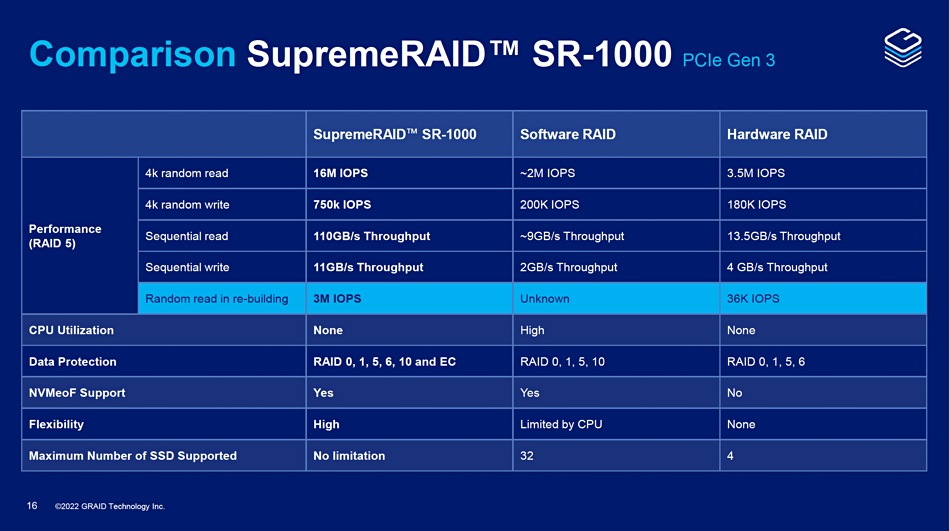GRAID has a performance comparison document that, on the numbers, would seem to kill the Broadcom competition pretty well stone dead – although it’s not compared itself with the best Broadcom card.
GRAID’s founder and CEO, Leander Yu, and GM Americas and EMEA, Tom Paquette, presented this to an IT Press Tour in Palo Alto. GRAID has developed a server CPU-offloading SupremeRAID card that fits inside a 1U server and is powered by a Tesla GPU. The multiple cores on the GPU process parity calculations in parallel and accelerate RAID processing for NVMe SSD access.

There are two products in the range. The SR-1000 uses PCIe 3 and delivers 16 million IOPS and 110GB/sec throughput with 32 SSDs. The S1010 uses PCIe 4 and delivers 19 million IOPS and 110GB/sec throughput with 32 SSDs. The card is in the control path, but not the data path. GRAID claims its card can help rebuild a failed 15TB (Solidigm) SSD in around two hours.

The cost of the SR-1000 varies between $2,500 and $3,995, depending on the feature set.
GRAID vs competition
GRAID’s marketeers have run up a comparison between the SR-1000, a Broadcom MegaRAID hardware card; one of the MegaRAID 9560 series, and Intel’s VROC software RAID, and it’s pretty compelling.

The top line is that the GRAID card does 16 million random read IOPS compared to the MegaRAID’s 3.5 million and the VROC’s 2 million. The random write numbers are of lower magnitude: 750K for the GRAID card vs 180K for Broadcom and 200K for VROC. The throughput numbers are overwhelmingly in GRAID’s favor, with its 101GB/sec trampling all over the 4GB/sec throughput for Broadcom and the 2GB/sec for VROC. GRAID is 25 times faster than the Broadcom hardware.
The random read IOPS numbers when rebuilding are impressive as well: 3 million for GRAID vs 36K for the MegaRAID card.
However, there are MegaRAID cards which have a higher performance than the one used in GRAID’s comparison. For example, Broadcom’s MegaRAID 9600 Series 24G PCIe 4 Tri-Mode RAID Adapter does 6 million to 6.4 million IOPS (4K RR) and supports 32 NVMe SSDs. That’s still less than the SupremeRAID card of course.
MegaRAID cards have a RAID-on-Chip (RoC) controller, such as the Avago SAS 3516 chip used in the tri-mode Fusion-MPT (Message Passing Technology) RoC. This has a 2-core ARM A15 CPU inside. The Arm-powered MegaRAID cards are up against Tesla T1000 GPU-powered SupremeRAID cards, with 2 Arm cores vs the 896 CUDA cores in the Tesla T1000 GPU. It’s pretty much no contest.
GRAID roadmap
GRAID is adding software features to improve its product’s appeal further.

The existing cards are billed as Enterprise Edition products. This year, GRAID will add a high-availability feature in a v1.3 release, due in the next 30 days. There will be two cards, each supporting 16 SSDs, and added performance improvements.
Next year it will introduce a Datacenter Edition Product line with support for Kubernetes and VMware, plus RAID clustering for NVMe-oF. Full erasure coding support will come in 2024, along with compression, encryption and deduplication. There will be thin provisioning as well and a cloud-native infrastructure. The RAID card becomes an even stronger CPU offload engine.
On the Enterprise Edition front PCIe 5 support will come next year, plus erasure coding. It gets thin provisioning in 2024 along with dynamic drive capacity extension.
Paquette said NVIDIA’s GPUDirect is also on the roadmap, as is support for Intel GPUs.
GRAID is planning its next funding round, recruiting more sales and marketing people, and looking for server OEM and partnering opportunities. Paquette said it had ScaleFlux computational storage drives in its lab.
We expect GRAID to grow its business at high speed. The market opportunity is vast, and the competition has been asleep at the wheel, ignoring the possibilities introduced by GPUs.








